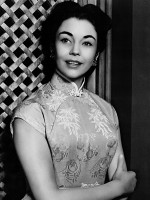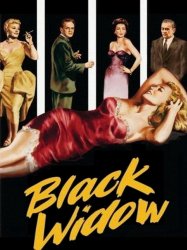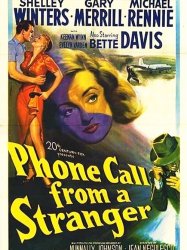The Man in the Gray Flannel Suit is a american film of genre Drama directed by Nunnally Johnson released in USA on 8 may 1956 with Gregory Peck
The Man in the Gray Flannel Suit (1956)

If you like this film, let us know!
- Infos
- Casting
- Technical infos
- Photos
- Videos
- Film quotes
- Characters
- Music
- Awards
Released in USA 8 may 1956
Length 2h33
Directed by Nunnally Johnson
OriginUSA
Genres Drama
Themes Children's films
Rating70%










The Man in the Gray Flannel Suit, by Sloan Wilson, is a 1955 novel about the American search for purpose in a world dominated by business. Tom and Betsy Rath share a struggle to find contentment in their hectic and material culture while several other characters fight essentially the same battle, but struggle in it for different reasons. In the end, it is a story of taking responsibility for one's own life. The book was largely autobiographical, drawing on Wilson's experiences as assistant director of the U.S. National Citizen Commission for Public Schools.
The novel was made into a movie in 1956, starring Gregory Peck and Jennifer Jones as Tom and Betsy Rath, with Fredric March, Lee J. Cobb, Keenan Wynn and Marisa Pavan in supporting roles. (March plays Tom Rath's boss, a character based on Roy Larsen, Wilson's boss at Time, Inc.) It was entered at the 1956 Cannes Film Festival.
Both movie and book became hugely popular. The novel continues to appear in the references of sociologists to America's discontented businessman. Columnist Bob Greene wrote, "The title of Sloan Wilson's best-selling novel became part of the American vernacular—the book was a ground-breaking fictional look at conformity in the executive suite, and it was a piece of writing that helped the nation's business community start to examine the effects of its perceived stodginess and sameness." Historian Robert Schultz argues that the film and the novel are cultural representations of what two-time presidential candidate (1952 and 1956) Adlai Stevenson described in a 1955 commencement address to Smith College women as a "crisis" in the western world, one Stevenson defined as "collectivism colliding with individualism," the collective corporate organization of postwar social and economic life. That increased corporate organization of society, Schultz notes, reduced white-collar workers' (represented by Tom Rath and the other gray-suited "yes men") control over what they did and how they did it as they adapted to the "organized system" described and critiqued by contemporary social critics such as Paul Goodman, C. Wright Mills and William H. Whyte, Jr.
The book was re-issued in 2002, with a foreword by author Jonathan Franzen.
Synopsis
Tom and Betsy Rath live in a rundown house in Westport, Connecticut around 1953 (1955 in the movie). They have three television-addicted children (two girls and a boy) and have money problems. Tom is 33 years old, a Harvard graduate. He barely survived as an Army paratroop officer during World War II, having fought in both the European and Pacific combat theaters, during which he had an extramarital affair.Actors

Gregory Peck
(Tom Rath)

Jennifer Jones
(Betsy Rath)

Fredric March
(Ralph Hopkins)

Ann Harding
(Helen Hopkins)

Keenan Wynn
(Sgt. Caesar Gardella)
Comments
Leave comment :
Suggestions of similar film to The Man in the Gray Flannel Suit
There are 294 films with the same actors, 7 films with the same director, 61691 with the same cinematographic genres, 5112 films with the same themes, to have finally 70 suggestions of similar films.If you liked The Man in the Gray Flannel Suit, you will probably like those similar films :

Black Widow (1954)
, 1h35Directed by Nunnally Johnson
Origin USA
Genres Drama, Thriller, Crime, Romance
Themes Serial killer films, Children's films
Actors Van Heflin, Ginger Rogers, Gene Tierney, George Raft, Otto Kruger, Peggy Ann Garner
Rating66%





Peter Denver (Van Heflin) is a renowned Broadway producer attending a party—hosted by the viciously haughty and celebrated actress Carlotta "Lottie" Marin (Ginger Rogers) and her quiet husband Brian Mullen (Reginald Gardiner)—when he meets Nancy "Nanny" Ordway (Peggy Ann Garner). Ordway is a seemingly naïve, 20-year-old, aspiring writer, who hopes to make it big in New York. She convinces a reluctant Denver to let her use his apartment to work during the day, while his wife, Iris (Gene Tierney), also a famous actress, is away, but with her permission. After the Denvers return from the airport and find Nancy hanging dead in their bathroom, a variety of people Ordway has recently met in New York begin to reveal deeper and darker connections with her. Lt. Bruce (George Raft), the detective assigned to the case, soon discovers that this apparent suicide was in fact a homicide and believes that Denver, quickly suspected of having an affair with Ordway, is the murderer. Denver evades arrest and seeks clues to discover the real murderer; the case becomes cluttered when he and Lt. Bruce independently realize that Ordway's dealings in New York have not been as innocent as her superficial personality.

The Man Who Understood Women (1959)
, 1h41Directed by Nunnally Johnson
Origin USA
Genres Comedy, Comedy-drama
Themes La provence, Children's films
Actors Henry Fonda, Leslie Caron, Renate Hoy, Marcel Dalio, Cesare Danova, Conrad Nagel
Rating44%





Willie Bauche, a Hollywood producer, becomes so obsessed with turning his wife, Ann Garantier, into the sexiest star in Hollywood that he neglects her real needs. Feeling lonely and tired of Tinseltown, Ann returns to her native France and finds herself attracted to Marco Ranieri, a handsome and very attentive pilot. When Willie hears about the budding affair, he flies into a rage and hires assassins to kill his rival. Unfortunately for him, the killers are romantics and decide that Ann and Marco are so in love that both must die so they can be together always. When Willie finds out, he rushes over to France to try and save his wife.

Oh, Men! Oh, Women! (1957)
, 1h30Directed by Nunnally Johnson
Origin USA
Genres Comedy
Themes Medical-themed films, Théâtre, Films about psychiatry, Films based on plays, Children's films
Actors Dan Dailey, Ginger Rogers, David Niven, Tony Randall, Barbara Rush, Natalie Schafer
Rating52%





Mildred Turner is a patient of a New York psychiatrist, Dr. Alan Coles. She is bored and frustrated in her marriage to a movie star, Arthur Turner.

Night People (1954)
, 1h33Directed by Nunnally Johnson
Origin USA
Genres Drama, War, Spy, Crime
Themes Spy films, Political films
Actors Gregory Peck, Broderick Crawford, Anita Björk, Rita Gam, Walter Abel, Buddy Ebsen
Rating64%





Allied enemies kidnap Corporal John "Johnny" Leatherby, a young American soldier in West Berlin. Lt. Col. Steve Van Dyke, the American provost marshal assigned to investigate, learns through his East German contact Frau "Hoffy" Hoffmeir that the soldier has been kidnapped by East German agents who want to trade him for a pair of elderly Germans. At the same time, the Soviet Union has closed border posts into Berlin, suggesting an impending international crisis. Johnny's father, Charles Leatherby, is a wealthy and politically influential industrialist from Toledo, Ohio, and flies to Berlin to bully the military bureaucracy into finding his son. Accustomed to being in charge and never refused, he issues a demand that the military attempt to bribe the East German government using Leatherby's money. Van Dyke is offended by Leatherby's arrogance and ignorance. ("You're a big wheel in the axle grease business. You're a personal friend of Senator...McDinglehoffer," he scoffs.

Phone Call from a Stranger (1952)
, 1h45Directed by Jean Negulesco
Origin USA
Genres Drama
Themes Transport films, Aviation films, Children's films
Actors Gary Merrill, Shelley Winters, Michael Rennie, Keenan Wynn, Beatrice Straight, Evelyn Varden
Rating69%





After his wife Jane (Helen Westcott) admits to an extramarital affair, Iowa attorney David Trask (Gary Merrill) abandons her and their daughters and heads for Los Angeles. His flight is delayed, and while waiting in the airport restaurant he meets a few of his fellow passengers. Troubled, alcoholic Dr. Robert Fortness (Michael Rennie), haunted by his responsibility for a car accident in which a colleague, Dr. Tim Brooks (Hugh Beaumont) was killed, is returning home to his wife Claire (Beatrice Straight) and teenage son Jerry (Ted Donaldson), and plans to tell the district attorney the truth about the accident. Aspiring actress Binky Gay (Shelley Winters) is hoping to free her husband Mike Carr (Craig Stevens) from the clutches of his domineering mother, former vaudevillian Sally Carr (Evelyn Varden), who looks down on Binky. Overly loud traveling salesman Eddie Hoke (Keenan Wynn) shares a photograph of his young, attractive wife Marie (Bette Davis) wearing a swimsuit. When a storm forces the plane to land en route, they continue to share their life stories via flashbacks during the unexpected four-hour layover. They exchange home phone numbers with the idea that they may one day have a reunion.

The Keys of the Kingdom (1944)
, 2h17Directed by Otto Brower, John M. Stahl
Origin USA
Genres Drama
Themes Films about religion, Children's films
Actors Gregory Peck, Thomas Mitchell, Vincent Price, Edmund Gwenn, Benson Fong, Rose Stradner
Rating71%





Father Francis Chisholm (Gregory Peck) is visited in his old age by Monsignor Sleeth (Sir Cedric Hardwicke) at his parish in Tweedside. The Monsignor informs Father Francis that the Bishop thinks it would be better if he retires, as Father Francis' somewhat unorthodox recent teachings have become a distraction. The Monsignor retires to his room in the rectory, and finds Father Francis' diary that recounts his story from 1878. As the Monsignor begins to read the diary, a flashback begins.

Les Misérables (1935)
, 1h48Directed by Richard Boleslawski
Origin USA
Genres Drama, Historical, Romance
Themes Children's films
Actors Fredric March, Charles Laughton, Cedric Hardwicke, Rochelle Hudson, Florence Eldridge, Marilyn Knowlden
Rating75%





Jean Valjean est un bagnard emprisonné pour un simple vol de pain parce qu'il était affamé. Il parvient à s'échapper et sur sa route, il rencontre un homme d'église qui changera sa vie. Il devient peu à peu un homme en vue de la ville où il s'est installé sous un faux nom pour échapper à son passé. La jeune Cosette que les vils Thénardiers exploitent à leur service, est recueillie par Valjean qui en prendra soin quant à son éducation. Mais l'inspecteur Javert, Policier obtus et convaincu que l'âme humaine ne peut changer, reconnaît en Valjean l'ancien détenu et veut à tout prix le compromettre...

The Affairs of Cellini (1934)
, 1h20Directed by Gregory La Cava
Origin USA
Genres Drama, Comedy, Comedy-drama, Historical
Themes Théâtre, Films based on plays, Children's films
Actors Frank Morgan, Constance Bennett, Fredric March, Fay Wray, Louis Calhern, Vince Barnett
Rating59%





Both the Duke and Duchess have an eye for beauty and other partners. The Duke presently fancies a young woman who poses as an artist's model. The Duchess has her eye on the famous artist, Benvenuto Cellini, who is in the palace making a set of gold plates to be used at ducal banquets. Cellini purportedly hypnotizes young women, and cuckolds the Duke of Florence. The somewhat oblivious Duke is loath to punish the young man, for Cellini fashions gold wares for him, but throws him into the torture chamber. However, a goblet of poisoned wine solves the problem.

Smith! (1969)
, 1h52Directed by Michael O'Herlihy
Origin USA
Genres Drama, Western
Themes Children's films
Actors Glenn Ford, Nancy Olson, Dean Jagger, Keenan Wynn, Warren Oates, Chief Dan George
Rating57%





Native American Jimmyboy (Frank Ramírez) flees to the ranch owned by Smith (Glenn Ford), a white man raised by a Native American. Jimmyboy has been accused of a crime by a white man and fears he will not receive a fair trial. Smith helps Jimmyboy deal with a cruel sheriff and persuades him to surrender to the local authorities, promising him he will act as a defence witness during court proceedings.

Tender Is the Night (1962)
, 2h22Directed by Henry King
Origin USA
Genres Drama, Romance
Themes Children's films
Actors Jennifer Jones, Jason Robards, Joan Fontaine, Tom Ewell, Cesare Danova, Jill St John
Rating59%





At a party in the south of France, when she sees her husband, Dr. Dick Diver, take an interest in an American movie starlet, Rosemary Hoyt, jealousy gets the better of Nicole Diver, a woman with many emotional issues.
 Connection
Connection